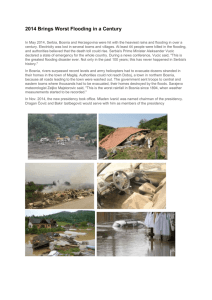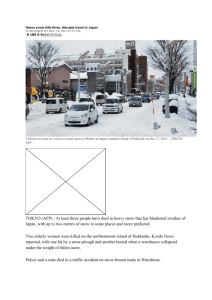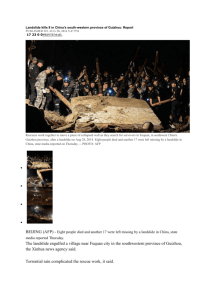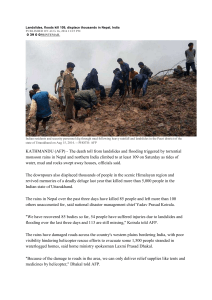Hazards and Management
advertisement
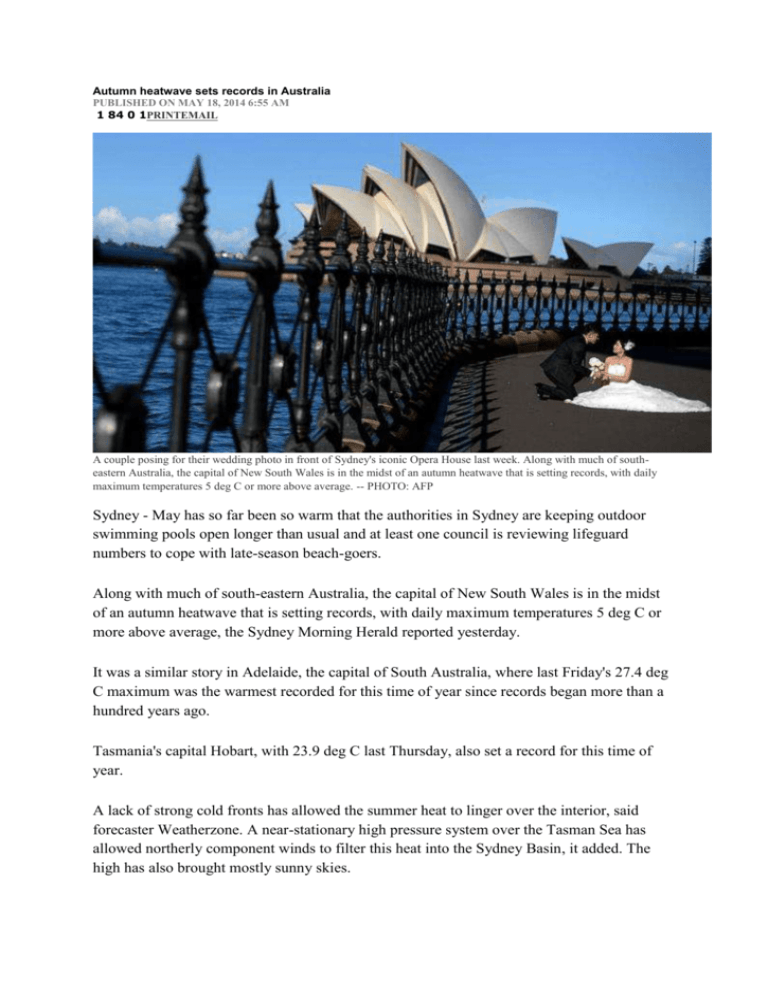
Autumn heatwave sets records in Australia PUBLISHED ON MAY 18, 2014 6:55 AM 1 84 0 1PRINTEMAIL A couple posing for their wedding photo in front of Sydney's iconic Opera House last week. Along with much of southeastern Australia, the capital of New South Wales is in the midst of an autumn heatwave that is setting records, with daily maximum temperatures 5 deg C or more above average. -- PHOTO: AFP Sydney - May has so far been so warm that the authorities in Sydney are keeping outdoor swimming pools open longer than usual and at least one council is reviewing lifeguard numbers to cope with late-season beach-goers. Along with much of south-eastern Australia, the capital of New South Wales is in the midst of an autumn heatwave that is setting records, with daily maximum temperatures 5 deg C or more above average, the Sydney Morning Herald reported yesterday. It was a similar story in Adelaide, the capital of South Australia, where last Friday's 27.4 deg C maximum was the warmest recorded for this time of year since records began more than a hundred years ago. Tasmania's capital Hobart, with 23.9 deg C last Thursday, also set a record for this time of year. A lack of strong cold fronts has allowed the summer heat to linger over the interior, said forecaster Weatherzone. A near-stationary high pressure system over the Tasman Sea has allowed northerly component winds to filter this heat into the Sydney Basin, it added. The high has also brought mostly sunny skies. Weatherzone meteorologist Ben Domensino told the Sydney Morning Herald: "At this time of year, we get our rain from the passage of the frontal systems. The highs are keeping the skies clear, which is allowing those temperatures to creep up, but it's also preventing any rainfall." The newspaper said the unseasonal warmth is causing problems for local councils and pool operators which organise lifeguard services. Volunteer lifesavers usually monitor beaches only until the end of April and many pools are often closed for the season by now. "We're not looking at closing it in a hurry. It's purely because the overnight temperatures have been so high... I'm not losing so much heat," Mr Reece Heddle, manager of aquatic services for Randwick City Council in Sydney, told the Herald. Weatherzone said since 1859, Sydney has only had 21 days in May where it has reached 25 deg C. "It's been significantly warmer than average throughout the country," with only a few cool pockets on the Queensland and West Australia coast, a senior climatologist at the Bureau of Meteorology, Dr Blair Trewin, told the Herald. Victoria's capital Melbourne is also in the midst of a warm spell. The city is expecting at least 10 days of 20 deg C weather, easily eclipsing the previous longest warm spell this late in the year of seven days, according to Weatherzone "Typically we get about two fronts every week (at this time of year), which keep the heat away. But we're likely to be going at least a week without one coming through," Weatherzone's Mr Brett Dutschke told Melbourne's The Age newspaper. It is bad news for farmers hoping for rains, said the newspaper. - See more at: http://www.straitstimes.com/news/asia/australianew-zealand/story/autumn-heatwave-sets-recordsaustralia-20140518#sthash.Ocw3C4jq.dpuf 6.2-magnitude earthquake strikes off Indonesia: USGS PUBLISHED ON MAY 18, 2014 11:06 AM 0 0 0 0PRINTEMAIL BANDA ACEH, Indonesia (AFP) - A 6.2-magnitude quake struck off the western Indonesian island of Sumatra Sunday, prompting panicked people to run out of their homes. However, there were no reports of damage and a tsunami warning was not issued. The US Geological Survey said the quake hit at a depth of nine kilometres (six miles), just over 300 kilometres west of the coastal city Banda Aceh. It occurred at around 7:00 am (8.00 am, SGT), USGS said. "The quake was felt strongly for a few seconds by residents on the west coast," said national disaster agency spokesman Sutopo Purwo Nugroho. "Some people ran out of their homes." But he added there had been no reports of damage. Mochammad Riyadi, from the Indonesian meteorology, climatology and geophysics agency, also said there were no reports of casualties or damages. "The magnitude may be big but the epicentre is at sea and relatively far away from the nearest city, Banda Aceh," he told AFP. Banda Aceh was devastated by a huge tsunami in 2004, which killed some 170,000 people in the surrounding region, as well as tens of thousands more in countries around the Indian Ocean. Indonesia sits on the Pacific "Ring of Fire" where continental plates collide, causing frequent seismic and volcanic activity. - See more at: http://www.straitstimes.com/news/asia/south-east-asia/story/62-magnitude-earthquake-strikesindonesia-usgs-20140518#sthash.WClfzDur.dpuf Bodies pulled from flooded homes in Bosnia, Serbia PUBLISHED ON MAY 17, 2014 7:24 PM 0 30 0 0PRINTEMAIL A Serbian emergency response worker carries a child as he and others evacuate people from their flooded homes in the town of Obrenovac, 40km west of Belgrade, on May 16, 2014. Emergency services pulled seven dead bodies from flooded homes in Bosnia on Saturday and soldiers rushed to free hundreds of people stranded in a school in Serbia during the worst floods to hit the Balkans in over a century. -- PHOTO : AFP OBRENOVAC (REUTERS) - Emergency services pulled seven dead bodies from flooded homes in Bosnia on Saturday and soldiers rushed to free hundreds of people stranded in a school in Serbia during the worst floods to hit the Balkans in over a century. A Reuters photographer in the town of Obrenovac, 30km southwest of the Serbian capital Belgrade and the worst hit by days of heavy rainfall, estimated the water level at 2-3 metres. "The whole town is under water," he said. Residents stood on roofs and terraces waiting to be rescued, while soldiers in amphibious military vehicles tried to evacuate an estimated 700 people, mainly women and children, from a primary school located on higher ground. Further to the west, thousands of volunteers joined soldiers, police and firefighters overnight in building sandbag flood defences around the town of Sabac, threatened by the rising waters of the River Sava. "Now we have to sit and wait, to wait for that next wave and to hope," Serbian Prime Minister Aleksandar Vucic told a news conference. Vucic said the first bodies had been found in Obrenovac, worst hit by the heaviest rainfall in the region since records began almost 120 years ago. He did not specify how many people had died. In Serbia, some 95,000 homes were without electricity on Saturday, with the country's energy system near breaking point. The country hiked imports to make up for a cut of 40 per cent in capacity. By Friday in Serbia, three people had drowned, including a rescue worker. In Bosnia, the death toll reached 11, with the discovery of six bodies in the eastern town of Doboj on Saturday and another in Samac in the north. "I'm afraid that won't be the end," Bosnian Serb leader Milorad Dodik told a news conference with Vucic in Belgrade. Authorities in Bosnia said they would evacuate about 10,000 people from the eastern region of Bijeljina, accomodating them in schools. Mayor Mico Micic appealed for blankets and food. Helicopters evacuated people from the northern Bosnian towns of Samac and Modrica and trucks and bulldozers carried food to the hardest hit areas. About 1,000 people, including babies, pregnant women, invalids and elderly were evacuated from the region of Zeljezno Polje in central Bosnia, where hundreds of homes were destroyed in landslides. "I think we'll never be able to return to our village," local Muslim imam Zuhdija Ridzal told Reuters by telephone from Zeljezno Polje. "It has disappeared in landslides." Serbia's state-run power utility Elektroprivreda Srbije (EPS) trimmed output at its largest hydro power plant, Djerdap 1, on the Danube river by a quarter and closed down 1,650 MW in capacity of its largest coal-fired power plant Nikola Tesla (TENT) late on Friday, on top of a 10 per cent cut in total output a day before. Flooding of the Kolubara, the Danube and the Sava rivers brought down cables and transformer stations, soaked coal depots that feed power plant and caused a fire inside the Kolubara power plant complex which had been shuttered since Thursday. - See more at: http://www.straitstimes.com/news/world/europe/story/bodies-pulled-floodied-homes-bosnia-serbia20140517#sthash.nvHKgIte.dpuf Cooler weather could help contain California fires PUBLISHED ON MAY 18, 2014 6:28 AM 0 17 0 0PRINTEMAIL A firefighter hoses flames at the Cocos fire on May 15, 2014 in San Marcos, California. Fire agencies throughout the state are scrambling to prepare for what is expected to be a dangerous year of wildfires in this third year of extreme drought in California. -- FILE PHOTO: AFP LOS ANGELES (AFP) - Firefighters battling blazes in southern California expressed optimism Saturday that cooler weather headed into the area could help their containment efforts. The fires have killed at least one person and forced the evacuation of thousands more over the past few days, including at a major Marine Corps base. Following sweltering temperatures, the National Weather Service announced that muchneeded relief was headed to the hard-hit San Diego area. Greatest cooling would be felt near the coast on Saturday before spreading inland, it said. “By Tuesday of next week, high temperatures are expected to be 10 to 20 degrees below average for this time of year. This is a drop of up to 40 degrees from the high temperatures this past Thursday at the peak of the heat,” it said on its website. That was welcome news for authorities on the ground, whose crews came face-to-face with so-called firenados – columns of rapidly rotating flames – at the height of the crisis. These were whipped up by strong seasonal Santa Ana winds, which since appear to have subsided. “The weather’s on our side,” Mike Mohler of Cal Fire, the Department of Forestry and Fire Protection, told CNN. “And I really feel, again cautiously optimistic, that we’re going to turn the corner on these fires today, we hope.” “Really, what was pushing those fires was that offshore Santa Ana wind, and that has completely subsided,” he said. “Right now, direct attack. Our focus is to get a containment line around all of the fires today.” Among the areas affected by the blazes is Camp Pendleton of the US Marine Corps, situated near San Diego. In a statement late on Friday, it said one of its housing evacuation orders had been lifted while others remained in place. Investigations are underway into what caused the fires. A 57-year-old man was charged Friday with starting one of them, local police said. The man, identified as Alberto Serrato, was allegedly seen stoking the flames of a small fire in the town of Oceanside on Wednesday. He pleaded not guilty to arson charges. Arrested after he tried to flee, he faces up to seven years in prison if found guilty. California and other western US states are routinely hit with wildfires during the summer and fall, but blazes have recently occurred earlier in the year. - See more at: http://www.straitstimes.com/news/world/americas/story/cooler-weather-could-help-containcalifornia-fires-20140518#sthash.3jSxamSY.dpuf
